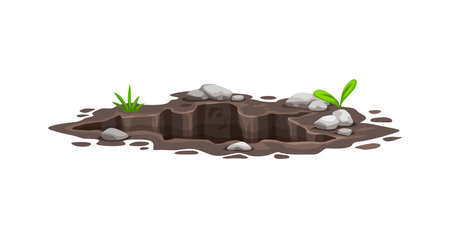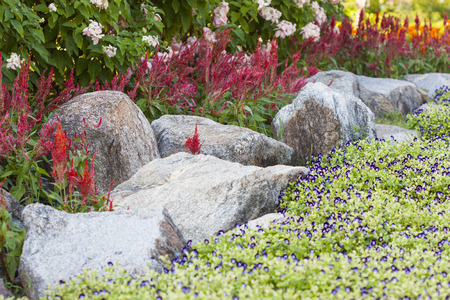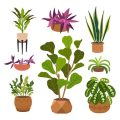1. Understanding the Basics of Rock Gardening
A rock garden, also known as an alpine garden, is a unique landscaping feature that combines rocks, gravel, and drought-tolerant plants to create a natural-looking, low-maintenance outdoor space. This style of gardening has become increasingly popular in American backyards due to its beauty, simplicity, and eco-friendly benefits.
What Is a Rock Garden?
At its core, a rock garden mimics the look of a mountainous or desert environment. It uses a combination of different-sized rocks and hardy plants that thrive in well-drained soil. These gardens often require little watering and can withstand harsh weather conditions, making them ideal for various climates across the U.S., especially in areas prone to drought.
Why Choose a Rock Garden?
There are several reasons why homeowners across the United States are turning to rock gardens as part of their backyard landscaping:
Benefits of Rock Gardens
| Benefit | Description |
|---|---|
| Low Maintenance | Requires less watering, mowing, and pruning compared to traditional lawns or flower beds. |
| Drought Tolerant | Perfect for dry regions like Arizona, Nevada, and parts of California where water conservation is key. |
| Visually Appealing | Adds texture and variety with stones and contrasting plant colors and shapes. |
| Eco-Friendly | Reduces the need for fertilizers and pesticides while supporting native plant species. |
| Year-Round Interest | Unlike seasonal gardens, rock gardens often maintain their structure and appeal all year long. |
Popular in American Backyards
In many parts of the U.S., especially in suburban neighborhoods, homeowners are shifting toward sustainable landscaping solutions. Rock gardens not only align with this trend but also offer a stylish way to personalize your outdoor space. Whether you live in a dry Southwestern state or a cooler Northern region, there’s a rock garden style that can fit your local environment.
Common Features in U.S. Rock Gardens:
- Boulders and river rocks arranged naturally
- Drought-resistant plants like sedum, lavender, or ornamental grasses
- Gravel pathways or mulch to reduce weed growth
- Minimalist design with focus on textures and color contrasts
If youre looking for an attractive yet easy-care way to enhance your backyard, starting with a rock garden might be the perfect choice. In the next section, we’ll explore how to plan your layout and choose the right location for your new landscape feature.
2. Planning Your Rock Garden Layout
Before you start placing rocks and plants in your backyard, it’s important to take time to plan out the layout of your rock garden. A well-thought-out design will not only look more natural but also thrive better over time. Here are some key steps to help you plan effectively.
Selecting the Right Location
Choosing the right spot is the first and most important step. Look for an area in your yard that naturally complements a rock garden. This could be a slope, a dry corner, or even a flat section that needs a visual upgrade. Consider how visible this location is from your patio or windows—after all, you’ll want to enjoy it!
Things to Consider When Choosing a Location:
| Factor | Why It Matters |
|---|---|
| Sunlight | Most rock garden plants love full sun. Choose a spot that gets at least 6 hours of direct sunlight daily. |
| Drainage | Poor drainage can cause root rot. Avoid low-lying areas where water tends to collect. |
| Accessibility | You’ll want to be able to access the garden for maintenance and enjoyment. |
Assessing Sunlight and Drainage
A successful rock garden mimics nature, especially alpine environments where plants grow between rocks with excellent drainage and lots of sun. Observe your chosen area at different times of day to see how sunlight moves across it. Also, test the soil after rainfall—if puddles linger for hours, you may need to improve drainage by elevating the bed or adding gravel underneath.
Designing a Natural-Looking Layout
A great rock garden feels like it belongs in nature, not like its been placed there randomly. Use uneven rock sizes and groupings to imitate what youd find on a mountain trail or desert landscape. Avoid symmetry and straight lines; instead, aim for balance through asymmetry and organic shapes.
Tips for Creating a Natural Look:
- Start with large rocks: Place them first to anchor your design.
- Create elevation changes: Mound soil or use slopes to add depth.
- Mimic natural clusters: Group rocks in odd numbers (like 3 or 5) for a more organic feel.
- Add planting pockets: Leave space between rocks for drought-tolerant plants like sedum or thyme.
Complementing Your Outdoor Space
Your rock garden should enhance your overall backyard style. Think about how it connects with existing landscaping elements such as pathways, decks, or fences. Use similar materials or colors found elsewhere in your yard so the design feels cohesive.
The planning stage sets the foundation for everything else. Take your time choosing the right location, evaluating sunlight and drainage, and designing a layout that feels both beautiful and natural in your outdoor space.

3. Selecting Rocks and Materials
Choosing the right rocks and materials is key to creating a beautiful and long-lasting rock garden. The textures, colors, and sizes of your stones will set the tone for your entire design. In this section, we’ll walk you through the most popular types of rocks used in American rock gardens, where you can find them, and how to complement your space with gravel, mulch, and other essential elements.
Best Types of Rocks for Your Rock Garden
Different rocks offer different aesthetics and benefits. Here are some of the most popular options you’ll find across U.S. rock gardens:
| Rock Type | Description | Best For | Common U.S. Sources |
|---|---|---|---|
| Limestone | Light-colored with a natural look; often used in dry climates. | Southwestern-style gardens | Texas, Indiana |
| Granite | Durable and available in many colors; adds texture and contrast. | Modern or minimalist styles | California, Colorado |
| Sandstone | Earthy tones with layered texture; weathers beautifully over time. | Naturalistic or desert landscapes | Arizona, Utah |
| Fieldstone | Irregular shapes and sizes; creates a rustic feel. | Cottage or woodland gardens | Pennsylvania, New York |
| Slate | Flat and smooth; great for pathways or stepping stones. | Zoned areas or footpaths in the garden | Vermont, Virginia |
Where to Source Rocks in the U.S.
You can find landscaping rocks at local garden centers, stone yards, or home improvement stores like Lowe’s and Home Depot. For larger projects or unique stones, try specialty stone suppliers or order from regional quarries. Some online retailers also offer bulk delivery if you dont have a truck handy.
Tips for Buying Rocks:
- Buy in bulk: It’s usually cheaper per ton than buying by the bag.
- Select locally sourced stone: It blends better with your environment and is more sustainable.
- Visit before you buy: Seeing the stone in person helps ensure youre happy with its size and color.
Incorporating Gravel, Mulch, and Other Materials
Apart from large rocks, smaller materials like gravel and mulch play an important role in defining spaces and improving drainage. Here’s a quick guide:
| Material | Description | Purpose in Rock Garden |
|---|---|---|
| Pea Gravel | Small, rounded stones that come in neutral colors. | Covers soil between plants; improves drainage. |
| Crumble Granite (Decomposed Granite) | Tiny granite particles that compact well underfoot. | Makes paths or base layers under larger rocks. |
| Bark Mulch (optional) | Naturally colored wood chips or shredded bark. | Adds contrast around non-rock areas or containers. |
A Quick Tip:
If you’re mixing materials like gravel and mulch, use metal edging or landscape fabric to keep them from blending together over time. This keeps your design clean and easy to maintain.
Create Texture Through Variety
The best rock gardens combine various sizes—from bold boulders to fine gravel—to create depth and interest. Don’t be afraid to mix tones as well—cool gray granite next to warm sandstone can add visual drama without feeling chaotic.
The choices you make here will shape your entire garden’s personality—so take your time exploring different materials before committing!
4. Choosing the Right Plants for Your Climate
When planning a rock garden, one of the most important steps is choosing plants that can handle your local climate. Since rock gardens are often low-maintenance and water-wise, selecting drought-tolerant and native plants will help your garden thrive with minimal effort. To make the best choices, its essential to consider your USDA hardiness zone, which helps determine what plants are most likely to survive and flourish in your region.
Why Drought-Tolerant and Native Plants Work Best
Drought-tolerant plants are naturally equipped to handle dry conditions, making them ideal for rock gardens where soil tends to drain quickly. Native plants are also a smart choice because theyre already adapted to your local weather, pests, and soil conditions. This means less watering, fewer chemicals, and an overall healthier garden ecosystem.
Recommended Plants by USDA Hardiness Zone
Here’s a handy guide to some popular drought-tolerant and native plants suitable for different USDA hardiness zones across the U.S.:
| USDA Zone | Recommended Plants | Plant Type |
|---|---|---|
| 3-4 (Northern U.S.) | Sedum, Pasque Flower, Prairie Smoke | Succulent, Perennial |
| 5-6 (Midwest & Northeast) | Coneflower, Yarrow, Russian Sage | Perennial, Shrub |
| 7-8 (South & Mid-Atlantic) | Black-Eyed Susan, Coreopsis, Lavender | Perennial, Herb |
| 9-10 (Southern California & Florida) | Agave, Ice Plant, Blanket Flower | Succulent, Ground Cover |
| 11+ (Tropical Zones) | Bougainvillea, Aloe Vera, Lantana | Shrub, Succulent |
Tips for Selecting and Planting Rock Garden Plants
Know Your Soil Type
A well-draining soil mix is key. Many drought-tolerant plants dislike soggy roots. Consider adding sand or gravel to improve drainage if needed.
Group Plants by Water Needs
This makes irrigation easier and more efficient. Even drought-tolerant plants need some water while they’re getting established.
Add Variety with Texture and Color
Select a mix of plants with different leaf shapes and bloom times for year-round interest. Succulents paired with flowering perennials can create a dynamic look.
Use Mulch Strategically
A layer of gravel or small rocks around plant bases helps retain moisture and keeps weeds at bay while enhancing the visual appeal of your garden.
Your Local Extension Office Can Help
If youre unsure about your hardiness zone or want more plant ideas specific to your region, check with your countys Cooperative Extension Office or local nursery—theyre great resources for regional gardening advice.
5. Building and Maintaining Your Rock Garden
Once youve planned your layout and chosen the right rocks and plants, its time to bring your rock garden to life. This step-by-step guide will walk you through the construction process and offer easy maintenance tips so your garden stays healthy and beautiful all year long.
Step-by-Step Guide to Building Your Rock Garden
- Clear the Area: Remove grass, weeds, and debris from your chosen site. You want a clean slate to work with.
- Plan for Drainage: Good drainage is essential. If your soil holds water, consider digging down a bit and adding a layer of gravel or sand before placing topsoil.
- Create the Base Shape: Use large rocks to define the shape and structure of your garden. These act as anchor points and provide height variation.
- Add Soil Mix: Fill in spaces between rocks with a well-draining soil mix. A combination of garden soil, sand, and compost works well.
- Place Smaller Rocks: Arrange smaller stones naturally around the larger ones. Avoid making patterns—random placement looks more organic.
- Plant Selection and Placement: Start placing your drought-tolerant plants like succulents or alpine varieties. Space them out to allow room for growth.
- Add Mulch or Gravel: Top off exposed soil with a layer of decorative gravel or mulch to help retain moisture and prevent weed growth.
Rock Garden Maintenance Tips
Your rock garden is low-maintenance by design, but regular care will keep it looking its best. Heres how to keep things tidy and thriving:
| Task | Frequency | Tips |
|---|---|---|
| Weeding | Every 1-2 weeks | Hand-pull weeds early before they spread; use mulch to reduce growth. |
| Watering | Drought-tolerant plants need minimal watering | Water deeply but infrequently—once every 1-2 weeks in dry spells. |
| Pruning & Trimming | A few times per season | Remove dead leaves or spent flowers to encourage new growth. |
| Pest Control | As needed | If pests appear, use natural remedies like neem oil or insecticidal soap. |
| Add Mulch/Gravel | Twice a year | Tidy up pathways and planting areas with fresh gravel or mulch in spring and fall. |
A Few Extra Tips
- Add solar-powered lights or small garden sculptures for visual interest at night.
- Avoid overwatering—most rock garden plants prefer dry conditions.
- If erosion becomes an issue, adjust rock placements or add groundcovers like creeping thyme to hold soil in place.
Your rock garden should be a relaxing retreat that reflects natures beauty. With just a little upkeep, it will reward you season after season with color, texture, and charm.


